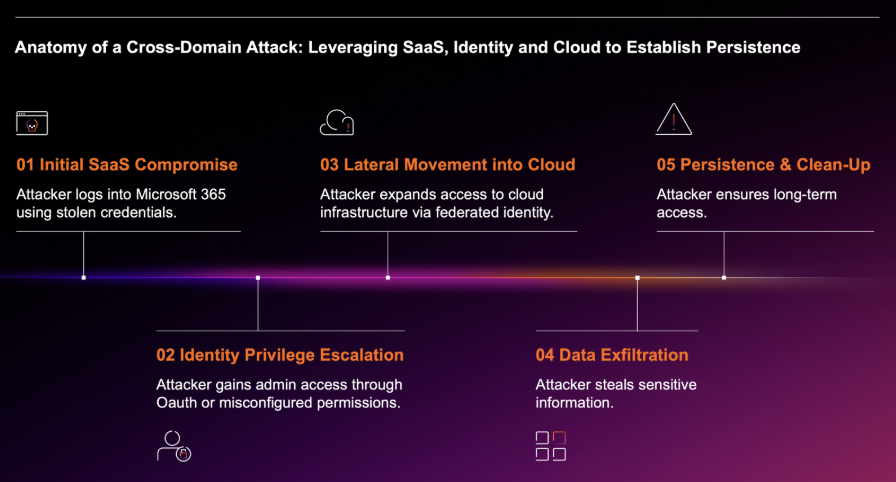‘Social engineering’. ‘Credential theft’. ‘Account takeover’. If you were a fly on the wall of a Security Operations Center in 2020, you would have heard these phrases far more often than ‘banking trojan’, ‘SQL injection’ or ‘exploit kit’. The reason for this is simple – the reality for most security teams now is that their perimeter has shifted into the cloud. Identities are being attacked more than devices.
‘Microsoft 365 account compromise’ is the current favorite, with 29% of organizations reporting a related incident in one month alone. Security teams struggle with these attacks because the evidence needed to detect them is scattered across the enterprise: they begin via email, are executed over the network, and progress in the cloud. This broad and spread out digital footprint means that following the breadcrumbs is not easy.
Darktrace’s Cyber AI Platform is designed to understand a user’s behavior as they move between devices and cloud services, tracking their activity to identify a compromise. To help understand how these attacks avoid detection, it is useful to look at a couple of examples of Microsoft Office 365 compromise detected recently in one of our customers.
Microsoft 365 compromised to launch external email threat
A Microsoft 365 account was recently compromised at a public accounting firm based in the United States. Darktrace initially picked up on several anomalies, including a sudden surge in outbound email traffic as well as the unusual login location – while the company and nearly all of its users were located in Wisconsin, an IP address located in Kansas was used to log in to the Microsoft 365 account. Along with the unusual login, a login to Microsoft Teams from the same Kansas IP address was detected.

Figure 1: Just after the new email rule was created, a Microsoft Teams 100% rare IP login occurred.
‘Impossible travel’ rules alone would have missed these anomalies, but an understanding of activity and behavior across different SaaS applications allowed Darktrace’s AI to recognize these events as one systematic case of credential theft. When the threat-actor subsequently created a new email rule, Darktrace was able to connect this event with the other anomalous behavior and understand its potentially malicious nature.

Figure 2: Darktrace’s SaaS Module noted a 100% rare IP logging into the user’s Microsoft 365 account and the creation of a new mailbox rules. All factors indicated 100% unusual SaaS activity.
Five minutes later, Antigena Email alerted on a large number of outbound emails containing a generic subject line and an attached PDF. The technology also detected that there was a clear spike in outbound emails from this user and flagged each of these emails with the “Out of Character” tag, which in this case denoted a change from normal behavior with the surge in recipients, and likely internal compromise.

Figure 3: Antigena Email detected a surge in recipients that indicated a serious breach of normal behavior for this user.
The unusual login behavior detected by Darktrace’s SaaS Module could be connected to the anomalous outbound email behavior flagged by Antigena Email, allowing the security team to see the extent of the attack and neutralize it as it emerged. It was clear that the account was being used to engage in malicious activity, as each of the 220 outbound emails used a generic subject line and contained a suspicious attachment. The security team therefore immediately disabled the compromised account.

Figure 4: A recreation of the email sent by the attacker, containing the malicious attachment.
‘Change of bank details’ sent from accounts department
When an Accounts Department’s Microsoft 365 account was compromised and used to send targeted phishing emails, Darktrace was able to track the attacker’s movement within the inbox, tying together information from Darktrace’s SaaS Module with Antigena Email’s alerts to understand the full picture of the threat and stop the attack.
The SaaS account appears to have been compromised via an inbound spear phishing attack, or some other form of attack that occurred before Darktrace began monitoring the organization. While Darktrace Cyber AI had no oversight of the initial compromise, it was still able to distinguish later attacker behavior as malicious, based on its actively evolving understanding of the organization and its workforce.
When the account user logged in from a 100% rare French IP address, Darktrace’s SaaS Module picked up on the anomaly immediately, and further detected a series of activities carried out after the unusual login. At the same time, Antigena Email noted an email being sent.

Figure 5: The login from a French IP was noted as 100% rare for this user and SaaS account.
Darktrace then identified more activity occurring from a second rare login location, a Swiss IP address. Very little email activity occurred when the account was logged in from this IP. Instead, Cyber AI saw the threat-actor using their illegitimate SaaS access to view information on the legitimate account user and files related to banking, invoices, and payments.
Antigena Email then identified a series of email communications that, when seen in the context of the SaaS account compromise, pointed to a clear threat. There were no obvious malicious attachments or links in the emails. However, the subject of the final reply was ‘Change of Bank Details’, and the email prompted a high Solicitation Inducement Score within Antigena Email, strongly implying that the malicious actor had sent emails instructing the destination to change payment details in order to route money to the attacker, instead of the company.
It seems the attackers went through the banking and invoicing files in order to find a customer with a big bill to pay, then used the compromised email account to launch an outbound phishing attack, changing the billing details. With Darktrace AI correlating information within the SaaS platform and insights from Antigena Email, this targeted phishing attack could be contained before further compromise or damage could occur.
The below screenshot also indicates a series of inbox processing rules made on the compromised account, showing actions that are typical of an account takeover.

Figure 6: Darktrace’s records of new inbox rules being set up on the compromised SaaS account.
The benefits of a unified approach
These stories are all too familiar. Most security tools would not be able to take action on any one of these steps individually. But the combination reveals the tell-tale sign of a Microsoft 365 account hijack. Organizations are struggling to manage their user identities across their cloud infrastructure, and rule and policy-based detection is no longer feasible.
However, by learning identities and behavior across the enterprise, Darktrace is able to detect, and seamlessly respond, to combat these threats. Hundreds of organizations are now using Antigena Email to protect their email and cloud environments continuously, trusting it to dynamically enforce MFA, lock accounts, block network traffic, and withhold emails when necessary.
As cloud-native applications become more popular, organizations face the growing problem of separate end-to-end security solutions for each type of workload. With Antigena Email working in conjunction with Darktrace’s Enterprise Immune System, defenders can be assured that a single, unified platform is tracking every suspicious behavior, wherever it arises in the organization.









































